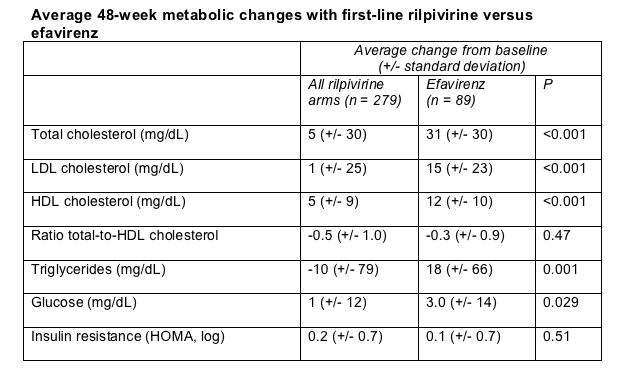 |
 |
 |
| |
Better Lipid Scores With TMC278 Than With Efavirenz
|
| |
| |
4th IAS Conference on HIV Pathogenesis, Treatment, and Prevention
July 22-25, 2007
Sydney, Australia
Mark Mascolini
After 48 weeks the new nonnucleoside rilpivirine (TMC278) caused fewer lipid abnormalities than efavirenz in previously untreated people [1]. But one lipid yardstick suggested little overall difference between the two nonnucleosides. Glucose levels rose more with efavirenz, though insulin resistance did not differ significantly between the two groups.
This ongoing randomized trial compares three doses of rilpivirine (25, 75, and 150 mg daily) with efavirenz--plus two nucleosides--in people starting their first antiretrovirals. Researchers randomized 279 people to one of the three rilpivirine doses and 89 to efavirenz. While 76% of study participants used AZT plus 3TC, 24% used tenofovir plus emtricitabine (FTC).
One third of trial enrollees were women, and just under half were white. Median age stood at 35 years. While pretreatment viral load averaged 69,300 copies in the combined rilpivirine arms, the average was 75,100 in the efavirenz group. Respective CD4 counts averaged 200 and 207. Metabolic variables in the two groups were similar before treatment began.
After 48 weeks of treatment, lipid, glucose, and insulin measures did not differ significantly between any two rilpivirine-treated groups. Total cholesterol, dangerous low-density lipoprotein (LDL) cholesterol, and triglycerides rose significantly more in the efavirenz group than in the combined rilpivirine arms (Table). In fact, average triglycerides fell with rilpivirine.

However, "good" high-density lipoprotein (HDL) cholesterol rose significantly more with efavirenz than with rilpivirine. As a result the 48-week ratio of total cholesterol to HDL cholesterol did not differ significantly between the efavirenz and rilpivirine arms. That result suggests a similar heart risk profile with the two drugs.
Glucose levels climbed significantly more with efavirenz than with rilpivirine (Table). But insulin resistance measured by the HOMA method did not differ significantly between the two nonnucleosides.
Reference
1. Ruxrungtham K, Bellos N, Morales-Ramirez J, et al. The metabolic profile of TMC278, an investigational non-nucleoside reverse transcriptase inhibitor (NNRTI). 4th IAS Conference on HIV Pathogenesis, Treatment, and Prevention. July 22-25, 2007. Sydney. Abstract TUAB105.
|
| |
|
 |
 |
|
|